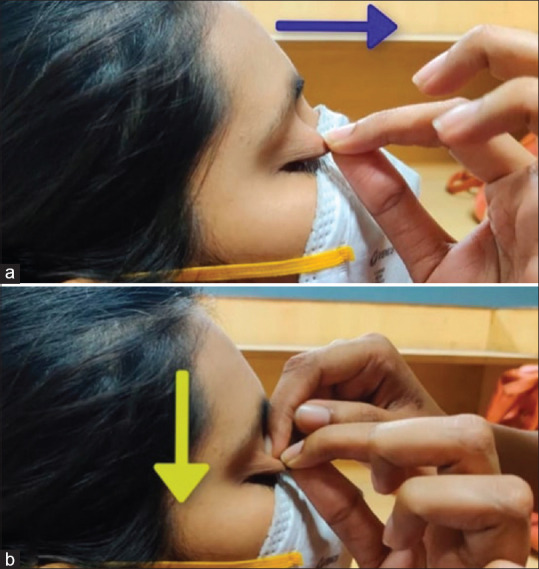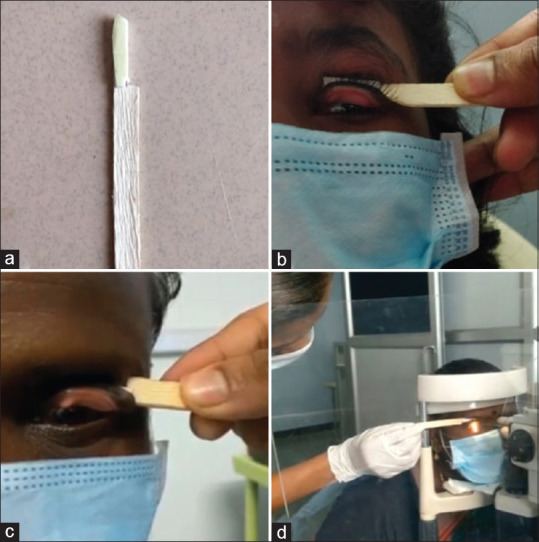Dear Editor,
In this era of the COVID-19 pandemic, there is a potential risk of transmission of viral infections during lid eversion due to the exposure of ocular fluids such as tears and conjunctival secretions following contact between the examiner’s finger and the patient’s bare ocular surface.[1,2] Lid eversion in deep sockets, madarosis, and pediatric patients are some of the other challenges faced. Alternate methods using paper clips[3] and wire speculum[4] have been described in the past but none reduce the risk of transmission of the infection. The principle of lid eversion consists of a combination of two forces—pulling force by fingers on the eyelashes [Fig. 1a] and a pushing force by fingers on the upper tarsus [Fig. 1b]. Adopting this, a simple tool which made no direct contact with the ocular surface was made using two materials: (a) Double-sided tape and (b) Ice cream stick. An ice cream stick was cut at one end with dimensions of 3.5 cm × 6 mm to which one side of the double-sided tape of dimensions 3.5 cm × 5 mm was stuck [Fig. 2a]. The other side of the tape adheres to the skin of the upper eyelid overlying the upper tarsus. The adherence of the double tape creates the pulling force on the upper eyelid and the rotational motion along the axis of the ice cream stick creates the pushing force on the tarsus just over its upper border everting the eyelid. It can be used to examine the upper tarsal conjunctiva, superior fornix and lid swellings, foreign body removal, saline wash in chemical injury, etc. [Fig. 2b and Video 1]. Double eversion can also be attempted [Fig. 2c]. Paramedical staff can also evert the upper eyelid while the doctor examines the patients [Fig. 2d]. Thus, I-Verter is a safe, universal, easily disposable, and economical DIY device for lid eversion with a minimum risk of infection.
Figure 1.

Figure showing (a) pulling force applied by fingers on the eyelashes, (b) pushing force by fingers on the upper tarsus
Figure 2.

(a) DIY I-Verter: Non-contact lid eversion tool (b) Figure showing lid eversion using I-Verter (c) Figure showing double eversion using I-Verter (d) Assistant doing eyelid eversion using I-Verter for foreign body removal
Financial support and sponsorship
Nil.
Conflicts of interest
There are no conflicts of interest.
Video available on: www.ijo.in
References
- 1.Kutti-Sridharan G, Vegunta R, Vegunta R, Mohan BP, Rokkam VRP. SARS-CoV2 in Different body fluids, risks of transmission, and preventing COVID-19:A comprehensive evidence-based review. Int J Prev Med. 2020;11:97. doi: 10.4103/ijpvm.IJPVM_255_20. [DOI] [PMC free article] [PubMed] [Google Scholar]
- 2.Sun S, Su W, Lin CQ, Li X, Yan H, Tian B, et al. COVID-19:The novel coronavirus disease and its manifestations and management in ophthalmology. Discov Med. 2020;29:145–57. [PubMed] [Google Scholar]
- 3.Cheng LHH, Kumar P. Retraction of oedematous eyelids with paper-clips. Ann R Coll Surg Engl. 2008;90:253. doi: 10.1308/003588408X285720a. [DOI] [PMC free article] [PubMed] [Google Scholar]
- 4.Aishwarya A, Gupta P, Tiwari US. Wire lid retractor –A new use of wire eye speculum. [Last accessed 2021 Feb 23];Indian J Ophthalmol. 2019 67:391–2. doi: 10.4103/ijo.IJO_1119_18. Available from: https://www.ijo.in/text.asp?2019/67/3/391/252398 . [DOI] [PMC free article] [PubMed] [Google Scholar]
Associated Data
This section collects any data citations, data availability statements, or supplementary materials included in this article.


